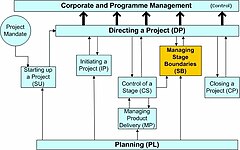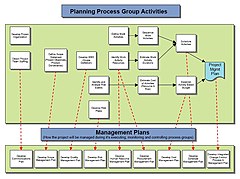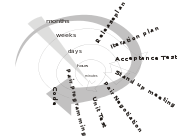A 'task' does not necessarily have to be called a 'project' in order for project management methods to be very useful in its planning and implementation. Even the smallest task can benefit from the use of a well-chosen project management technique or tool, especially in the planning stage.
Project management has been practiced since early civilization. Until 1900 civil engineering projects were generally managed by creative architects and engineers themselves, among those for example Vitruvius (1st century BC), Christopher Wren (1632–1723) , Thomas Telford (1757–1834) and Isambard Kingdom Brunel (1806–1859).[ It was in the 1950s that organizations started to systematically apply project management tools and techniques to complex engineering projects.
As a discipline, Project Management developed from several fields of application including civil construction, engineering, and heavy defense activity.[8] Two forefathers of project management are Henry Gantt, called the father of planning and control techniques,[9] who is famous for his use of the Gantt chart as a project management tool; and Henri Fayol for his creation of the 5 management functions which form the foundation of the body of knowledge associated with project and program management.[10] Both Gantt and Fayol were students of Frederick Winslow Taylor's theories of scientific management. His work is the forerunner to modern project management tools including work breakdown structure (WBS) and resource allocation.
The 1950s marked the beginning of the modern Project Management era where core engineering fields come together working as one. Project management became recognized as a distinct discipline arising from the management discipline with engineering model.[11] In the United States, prior to the 1950s, projects were managed on an ad hoc basis using mostly Gantt Charts, and informal techniques and tools. At that time, two mathematical project-scheduling models were developed. The "Critical Path Method" (CPM) was developed as a joint venture between DuPont Corporation and Remington Rand Corporation for managing plant maintenance projects. And the "Program Evaluation and Review Technique" or PERT, was developed by Booz Allen Hamilton as part of the United States Navy's (in conjunction with the Lockheed Corporation) Polaris missile submarine program;[12] These mathematical techniques quickly spread into many private enterprises.

The International Project Management Association (IPMA) was founded in Europe in 1967,[13] as a federation of several national project management associations. IPMA maintains its federal structure today and now includes member associations on every continent except Antarctica. IPMA offers a Four Level Certification program based on the IPMA Competence Baseline (ICB).[14] The ICB covers technical competences, contextual competences, and behavioral competences.
In 1969, the Project Management Institute (PMI) was formed in the USA.[15] PMI publishes A Guide to the Project Management Body of Knowledge (PMBOK Guide), which describes project management practices that are common to "most projects, most of the time." PMI also offers multiple certifications.
The American Academy of Project Management (AAPM) International Board of Standards 1996 was the first to institute post-graduate certifications such as the MPM Master Project Manager, PME Project Management E-Business, CEC Certified-Ecommerce Consultant, and CIPM Certified International Project Manager. The AAPM also issues the post-graduate standards body of knowledge for executives.
Approaches
There are a number of approaches to managing project activities including agile, interactive, incremental, and phased approaches.Regardless of the methodology employed, careful consideration must be given to the overall project objectives, timeline, and cost, as well as the roles and responsibilities of all participants and stakeholders.
The traditional approach
A traditional phased approach identifies a sequence of steps to be completed. In the "traditional approach", we can distinguish 5 components of a project (4 stages plus control) in the development of a project:- Project initiation stage;
- Project planning and design stage;
- Project execution and construction stage;
- Project monitoring and controlling systems;
- Project completion.
Many industries use variations on these project stages. For example, when working on a brick and mortar design and construction, projects will typically progress through stages like Pre-Planning, Conceptual Design, Schematic Design, Design Development, Construction Drawings (or Contract Documents), and Construction Administration. In software development, this approach is often known as the waterfall model,[16] i.e., one series of tasks after another in linear sequence. In software development many organizations have adapted the Rational Unified Process (RUP) to fit this methodology, although RUP does not require or explicitly recommend this practice. Waterfall development works well for small, well defined projects, but often fails in larger projects of undefined and ambiguous nature. The Cone of Uncertainty explains some of this as the planning made on the initial phase of the project suffers from a high degree of uncertainty. This becomes especially true as software development is often the realization of a new or novel product. In projects where requirements have not been finalized and can change, requirements management is used to develop an accurate and complete definition of the behavior of software that can serve as the basis for software development.[17] While the terms may differ from industry to industry, the actual stages typically follow common steps to problem solving — "defining the problem, weighing options, choosing a path, implementation and evaluation."
Critical Chain Project Management
Critical Chain Project Management (CCPM) is a method of planning and managing projects that puts more emphasis on the resources (physical and human) needed in order to execute project tasks. The most complex part involves engineering professionals of different fields (Civil, Electrical, Mechanical etc) working together. It is an application of the Theory of Constraints (TOC) to projects. The goal is to increase the rate of throughput (or completion rates) of projects in an organization. Applying the first three of the five focusing steps of TOC, the system constraint for all projects is identified as are the resources. To exploit the constraint, tasks on the critical chain are given priority over all other activities. Finally, projects are planned and managed to ensure that the resources are ready when the critical chain tasks must start, subordinating all other resources to the critical chain.Regardless of project type, the project plan should undergo Resource Leveling, and the longest sequence of resource-constrained tasks should be identified as the critical chain. In multi-project environments, resource leveling should be performed across projects. However, it is often enough to identify (or simply select) a single "drum" resource—a resource that acts as a constraint across projects—and stagger projects based on the availability of that single resource.
Extreme Project Management
In critical studies of Project Management, it has been noted that several of these fundamentally PERT-based models are not well suited for the multi-project company environment of today.[citation needed] Most of them are aimed at very large-scale, one-time, non-routine projects, and nowadays all kinds of management are expressed in terms of projects.Using complex models for "projects" (or rather "tasks") spanning a few weeks has been proven to cause unnecessary costs and low maneuverability in several cases[citation needed]. Instead, project management experts try to identify different "lightweight" models, such as Agile Project Management methods including Extreme Programming for software development and Scrum techniques.
The generalization of Extreme Programming to other kinds of projects is extreme project management, which may be used in combination with the process modeling and management principles of human interaction management.
Event chain methodology
Event chain methodology is another method that complements critical path method and critical chain project management methodologies.Event chain methodology is an uncertainty modeling and schedule network analysis technique that is focused on identifying and managing events and event chains that affect project schedules. Event chain methodology helps to mitigate the negative impact of psychological heuristics and biases, as well as to allow for easy modeling of uncertainties in the project schedules. Event chain methodology is based on the following principles.
- Probabilistic moment of risk: An activity (task) in most real life processes is not a continuous uniform process. Tasks are affected by external events, which can occur at some point in the middle of the task.
- Event chains: Events can cause other events, which will create event chains. These event chains can significantly affect the course of the project. Quantitative analysis is used to determine a cumulative effect of these event chains on the project schedule.
- Critical events or event chains: The single events or the event chains that have the most potential to affect the projects are the “critical events” or “critical chains of events.” They can be determined by the analysis.
- Project tracking with events: Even if a project is partially completed and data about the project duration, cost, and events occurred is available, it is still possible to refine information about future potential events and helps to forecast future project performance.
- Event chain visualization: Events and event chains can be visualized using event chain diagrams on a Gantt chart.

PRINCE2
PRINCE2 is a structured approach to project management, released in 1996 as a generic project management method.[18] It combined the original PROMPT methodology (which evolved into the PRINCE methodology) with IBM's MITP (managing the implementation of the total project) methodology. PRINCE2 provides a method for managing projects within a clearly defined framework. PRINCE2 describes procedures to coordinate people and activities in a project, how to design and supervise the project, and what to do if the project has to be adjusted if it does not develop as planned.In the method, each process is specified with its key inputs and outputs and with specific goals and activities to be carried out. This allows for automatic control of any deviations from the plan. Divided into manageable stages, the method enables an efficient control of resources. On the basis of close monitoring, the project can be carried out in a controlled and organized way.
PRINCE2 provides a common language for all participants in the project. The various management roles and responsibilities involved in a project are fully described and are adaptable to suit the complexity of the project and skills of the organization.
[edit] Process-based management
Also furthering the concept of project control is the incorporation of process-based management. This area has been driven by the use of Maturity models such as the CMMI (Capability Maturity Model Integration) and ISO/IEC15504 (SPICE - Software Process Improvement and Capability Estimation).Agile Project Management
Agile Project Management approaches based on the principles of human interaction management are founded on a process view of human collaboration. This contrasts sharply with the traditional approach. In the agile software development or flexible product development approach, the project is seen as a series of relatively small tasks conceived and executed as the situation demands in an adaptive manner, rather than as a completely pre-planned process.Processes
Traditionally, project management includes a number of elements: four to five process groups, and a control system. Regardless of the methodology or terminology used, the same basic project management processes will be used.
- Initiation
- Planning or development
- Production or execution
- Monitoring and controlling
- Closing
Initiation

The initiation stage should include a plan that encompasses the following areas:
- Analyzing the business needs/requirements in measurable goals
- Reviewing of the current operations
- Financial analysis of the costs and benefits including a budget
- Stakeholder analysis, including users, and support personnel for the project
- Project charter including costs, tasks, deliverables, and schedule
Planning and design

Project planning generally consists of[22]
- determining how to plan (e.g. by level of detail or rolling wave);
- developing the scope statement;
- selecting the planning team;
- identifying deliverables and creating the work breakdown structure;
- identifying the activities needed to complete those deliverables and networking the activities in their logical sequence;
- estimating the resource requirements for the activities;
- estimating time and cost for activities;
- developing the schedule;
- developing the budget;
- risk planning;
- gaining formal approval to begin work.
For new product development projects, conceptual design of the operation of the final product may be performed concurrent with the project planning activities, and may help to inform the planning team when identifying deliverables and planning activities.
Executing

Monitoring and controlling
Monitoring and controlling consists of those processes performed to observe project execution so that potential problems can be identified in a timely manner and corrective action can be taken, when necessary, to control the execution of the project. The key benefit is that project performance is observed and measured regularly to identify variances from the project management plan.
- Measuring the ongoing project activities ('where we are');
- Monitoring the project variables (cost, effort, scope, etc.) against the project management plan and the project performance baseline (where we should be);
- Identify corrective actions to address issues and risks properly (How can we get on track again);
- Influencing the factors that could circumvent integrated change control so only approved changes are implemented
Project Maintenance is an ongoing process, and it includes:[20]
- Continuing support of end users
- Correction of errors
- Updates of the software over time
Over the course of any construction project, the work scope may change. Change is a normal and expected part of the construction process. Changes can be the result of necessary design modifications, differing site conditions, material availability, contractor-requested changes, value engineering and impacts from third parties, to name a few. Beyond executing the change in the field, the change normally needs to be documented to show what was actually constructed. This is referred to as Change Management. Hence, the owner usually requires a final record to show all changes or, more specifically, any change that modifies the tangible portions of the finished work. The record is made on the contract documents – usually, but not necessarily limited to, the design drawings. The end product of this effort is what the industry terms as-built drawings, or more simply, “as built.” The requirement for providing them is a norm in construction contracts.
When changes are introduced to the project, the viability of the project has to be re-assessed. It is important not to lose sight of the initial goals and targets of the projects. When the changes accumulate, the forecasted result may not justify the original proposed investment in the project.
Closing

This phase consists of:[20]
- Project close: Finalize all activities across all of the process groups to formally close the project or a project phase
- Contract closure: Complete and settle each contract (including the resolution of any open items) and close each contract applicable to the project or project phase.
Project control systems
Project control is that element of a project that keeps it on-track, on-time and within budget.[23] Project control begins early in the project with planning and ends late in the project with post-implementation review, having a thorough involvement of each step in the process. Each project should be assessed for the appropriate level of control needed: too much control is too time consuming, too little control is very risky. If project control is not implemented correctly, the cost to the business should be clarified in terms of errors, fixes, and additional audit fees.Control systems are needed for cost, risk, quality, communication, time, change, procurement, and human resources. In addition, auditors should consider how important the projects are to the financial statements, how reliant the stakeholders are on controls, and how many controls exist. Auditors should review the development process and procedures for how they are implemented. The process of development and the quality of the final product may also be assessed if needed or requested. A business may want the auditing firm to be involved throughout the process to catch problems earlier on so that they can be fixed more easily. An auditor can serve as a controls consultant as part of the development team or as an independent auditor as part of an audit.
Businesses sometimes use formal systems development processes. These help assure that systems are developed successfully. A formal process is more effective in creating strong controls, and auditors should review this process to confirm that it is well designed and is followed in practice. A good formal systems development plan outlines:









0 comments:
Post a Comment